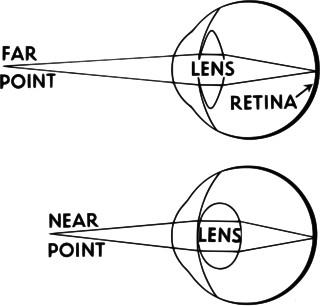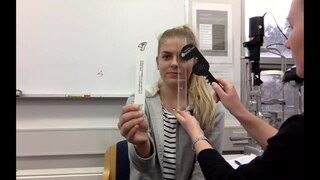Related Research Articles

Myopia, also known as near-sightedness and short-sightedness, is an eye disease where light from distant objects focuses in front of, instead of on, the retina. As a result, distant objects appear blurry while close objects appear normal. Other symptoms may include headaches and eye strain. Severe myopia is associated with an increased risk of macular degeneration, retinal detachment, cataracts, and glaucoma.

A dioptre or diopter, symbol dpt or D, is a unit of measurement with dimension of reciprocal length, equivalent to one reciprocal metre, 1 dpt = 1 m−1. It is normally used to express the optical power of a lens or curved mirror, which is a physical quantity equal to the reciprocal of the focal length, expressed in metres. For example, a 3-dioptre lens brings parallel rays of light to focus at 1⁄3 metre. A flat window has an optical power of zero dioptres, as it does not cause light to converge or diverge. Dioptres are also sometimes used for other reciprocals of distance, particularly radii of curvature and the vergence of optical beams.

Esotropia is a form of strabismus in which one or both eyes turn inward. The condition can be constantly present, or occur intermittently, and can give the affected individual a "cross-eyed" appearance. It is the opposite of exotropia and usually involves more severe axis deviation than esophoria. Esotropia is sometimes erroneously called "lazy eye", which describes the condition of amblyopia; a reduction in vision of one or both eyes that is not the result of any pathology of the eye and cannot be resolved by the use of corrective lenses. Amblyopia can, however, arise as a result of esotropia occurring in childhood: In order to relieve symptoms of diplopia or double vision, the child's brain will ignore or "suppress" the image from the esotropic eye, which when allowed to continue untreated will lead to the development of amblyopia. Treatment options for esotropia include glasses to correct refractive errors, the use of prisms, orthoptic exercises, or eye muscle surgery.

Far-sightedness, also known as long-sightedness, hypermetropia, and hyperopia, is a condition of the eye where distant objects are seen clearly but near objects appear blurred. This blur is due to incoming light being focused behind, instead of on, the retina due to insufficient accommodation by the lens. Minor hypermetropia in young patients is usually corrected by their accommodation, without any defects in vision. But, due to this accommodative effort for distant vision, people may complain of eye strain during prolonged reading. If the hypermetropia is high, there will be defective vision for both distance and near. People may also experience accommodative dysfunction, binocular dysfunction, amblyopia, and strabismus. Newborns are almost invariably hypermetropic, but it gradually decreases as the newborn gets older.

Presbyopia is a physiological insufficiency of optical accommodation associated with the aging of the eye; it results in progressively worsening ability to focus clearly on close objects. Also known as age-related farsightedness, it affects many adults over the age of 40. A common sign of presbyopia is difficulty in reading small print, which results in having to hold reading material farther away. Other symptoms associated can be headaches and eyestrain. Different people experience different degrees of problems. Other types of refractive errors may exist at the same time as presbyopia. This condition is similar to hypermetropia or far-sightedness, which starts in childhood and exhibits similar symptoms of blur in the vision for close objects.

An eyeglass prescription is an order written by an eyewear prescriber, such as an optometrist, that specifies the value of all parameters the prescriber has deemed necessary to construct and/or dispense corrective lenses appropriate for a patient. If an eye examination indicates that corrective lenses are appropriate, the prescriber generally provides the patient with an eyewear prescription at the conclusion of the exam.

An eye examination, commonly known as an eye test, is a series of tests performed to assess vision and ability to focus on and discern objects. It also includes other tests and examinations of the eyes. Eye examinations are primarily performed by an optometrist, ophthalmologist, or an orthoptist. Health care professionals often recommend that all people should have periodic and thorough eye examinations as part of routine primary care, especially since many eye diseases are asymptomatic. Typically, a healthy individual who otherwise has no concerns with their eyes receives an eye exam once in their 20s and twice in their 30s.

The accommodation reflex is a reflex action of the eye, in response to focusing on a near object, then looking at a distant object, comprising coordinated changes in vergence, lens shape (accommodation) and pupil size. It is dependent on cranial nerve II, superior centers (interneuron) and cranial nerve III. The change in the shape of the lens is controlled by ciliary muscles inside the eye. Changes in contraction of the ciliary muscles alter the focal distance of the eye, causing nearer or farther images to come into focus on the retina; this process is known as accommodation. The reflex, controlled by the parasympathetic nervous system, involves three responses: pupil constriction, lens accommodation, and convergence.

Accommodation is the process by which the vertebrate eye changes optical power to maintain a clear image or focus on an object as its distance varies. In this, distances vary for individuals from the far point—the maximum distance from the eye for which a clear image of an object can be seen, to the near point—the minimum distance for a clear image. Accommodation usually acts like a reflex, including part of the accommodation-convergence reflex, but it can also be consciously controlled.
Vision therapy (VT), or behavioral optometry, is an umbrella term for alternative medicine treatments using eye exercises, based around the pseudoscientific claim that vision problems are the true underlying cause of learning difficulties, particularly in children. Vision therapy has not been shown to be effective using scientific studies, except for helping with convergence insufficiency. Most claims—for example that the therapy can address neurological, educational, and spatial difficulties—lack supporting evidence. Neither the American Academy of Pediatrics nor the American Academy of Ophthalmology support the use of vision therapy.

A phoropter or refractor is an ophthalmic testing device. It is commonly used by eye care professionals during an eye examination, and contains different lenses used for refraction of the eye during sight testing, to measure an individual's refractive error and determine their eyeglass prescription. It also is used to measure the patients' phorias and ductions, which are characteristics of binocularity.

A vergence is the simultaneous movement of both eyes in opposite directions to obtain or maintain single binocular vision.
Convergence insufficiency is a sensory and neuromuscular anomaly of the binocular vision system, characterized by a reduced ability of the eyes to turn towards each other, or sustain convergence.
Positive relative accommodation (PRA) in biology, is a measure of the maximum ability to stimulate eye accommodation while maintaining clear, single binocular vision. This measurement is typically obtained by an orthoptist, ophthalmologist or optometrist during an eye examination using a phoropter. After the patient's distance correction is established, she or he is instructed to view small letters on a card 40 cm from the eyes. The examiner adds lenses in −0.25 diopter increments until the patient first reports that they become blurry. The total value of the lenses added to reach this point is the PRA value.

Fixation disparity is a tendency of the eyes to drift in the direction of the heterophoria. While the heterophoria refers to a fusion-free vergence state, the fixation disparity refers to a small misalignment of the visual axes when both eyes are open in an observer with normal fusion and binocular vision. The misalignment may be vertical, horizontal or both. The misalignment is much smaller than that of strabismus. While strabismus prevents binocular vision, fixation disparity keeps binocular vision, however it may reduce a patient's level of stereopsis. A patient may have a different fixation disparity at distance than near. Observers with a fixation disparity are more likely to report eye strain in demanding visual tasks; therefore, tests of fixation disparity belong to the diagnostic tools used by eye care professionals: remediation includes vision therapy, prism eye glasses, or visual ergonomics at the workplace.
Accommodative insufficiency (AI) involves the inability of the eye to focus properly on an object. Accommodation is the adjustment of the curvature of the lens to focus on objects near and far.
The eye, like any other optical system, suffers from a number of specific optical aberrations. The optical quality of the eye is limited by optical aberrations, diffraction and scatter. Correction of spherocylindrical refractive errors has been possible for nearly two centuries following Airy's development of methods to measure and correct ocular astigmatism. It has only recently become possible to measure the aberrations of the eye and with the advent of refractive surgery it might be possible to correct certain types of irregular astigmatism.

The prism cover test (PCT) is an objective measurement and the gold standard in measuring strabismus, i.e. ocular misalignment, or a deviation of the eye. It is used by ophthalmologists and orthoptists in order to measure the vertical and horizontal deviation and includes both manifest and latent components. Manifest is defined by the eye deviating constantly or intermittently, whereas latent is where the deviation is normally controlled but becomes present when the eyes are dissociated. A PCT reveals the total deviation and cannot distinguish between latent and manifest strabismus as you are using an alternate cover test.

The prism fusion range (PFR) or fusional vergence amplitude is a clinical eye test performed by orthoptists, optometrists, and ophthalmologists to assess motor fusion, specifically the extent to which a patient can maintain binocular single vision (BSV) in the presence of increasing vergence demands. Motor fusion is largely accounted to amplitudes of fusional vergences and relative fusional vergences. Fusional vergence is the maximum vergence movement enabling BSV and the limit is at the point of diplopia. Relative fusional vergence is the maximum vergence movement enabling a patient to see a comfortable clear image and the limit is represented by the first point of blur. These motor fusion functions should fall within average values so that BSV can be comfortably achieved. Excessive stress on the vergence system or inability to converge or diverge adequately can lead to asthenopic symptoms, which generally result from decompensation of latent deviations (heterophoria) or loss of control of ocular misalignments. Motor anomalies can be managed in various ways, however, in order to commence treatment, motor fusion testing such as the PFR is required.

Vergence-accommodation conflict (VAC), also known as accommodation-vergence conflict, is a visual phenomenon that occurs when the brain receives mismatching cues between vergence and accommodation of the eye. This commonly occurs in virtual reality devices, augmented reality devices, 3D movies, and other types of stereoscopic displays and autostereoscopic displays. The effect can be unpleasant and cause eye strain.
References
- ↑ Cassin, B. and Solomon, S. Dictionary of Eye Terminology. Gainesville, Florida: Triad Publishing Company, 1990.
- ↑ Schor C, Narayan V. Graphical analysis of prism adaptation, convergence accommodation, and accommodative convergence. Am J Optom Physiol Optics. 1982;59:774-784.
- ↑ Wick B, Currie D. Convergence accommodation: Laboratory and clinical evaluation. Optom Vis Sci. 1991;68:226-231.